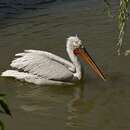en
names in breadcrumbs


The family Pelecanidae contains just a single genus, Pelecanus.The seven or eight species in the genus Pelecanus (the sole genus in the family Pelecanidae) are all commonly known as pelicans. Pelicans are found throughout most tropical and temperate regions around the world. All pelicans are large birds with broad wings and a distensible pouch. These are social birds that breed, feed, and fly in groups. They take 3 to 4 years to reach maturity. Most species fish together in small flocks, driving fish from deeper water into shallows and submerging their open bills to scoop up fish. Pelicans are generally very sensitive to human disturbance and will desert eggs easily.
The Great White Pelican (P. onocrotalus) is restricted to the Old World, where its distribution overlaps that of the Dalmatian and Pink-backed Pelicans. It has a patchy breeding distribution from the eastern Mediterranean to Southeast Asia and is resident in Africa from Mauritania and Ethiopia south to South Africa. This is the second largest of the world's pelicans. Great White Pelicans are found mainly around fresh or brackish water (sometimes marine in Africa) and are gregarious throughout the year.
The Pink-backed Pelican (P. rufescens) is found in subtropical and tropical Africa, where it overlaps in range with the larger Great White Pelican. The Pink-backed Pelican occurs throughout Africa south of the Sahara (formerly including Madagascar) and north to around 25 N in the Red Sea. Unlike the Great White Pelican, it often roosts in trees. The Pink-backed Pelican breeds colonially, mainly around freshwater, and is gregarious throughout the year.
The relatively small Spot-billed Pelican (P. philippensis) occurs in Asia, overlapping in range with the larger Great White and Dalmatian Pelicans (this taxon has sometimes been treated as conspecific with the Dalmatian Pelican, with whose range it overlaps on the Indian subcontinent in winter). It once bred widely in southern Asia, but breeding may now be restricted to India, Sri Lanka, and Cambodia. Like most pelican species, Spot-billed Pelicans spend most of their time around fresh or brackish water. They breeds colonially and are gregarious throughout the year.
The Dalmatian Pelican (P. crispus) is the largest Eurasian pelican and is now an endangered species. Its range overlaps with that of the Great White and Pink-backed Pelicans. Dalmatian Pelicans breed colonially on freshwater lakes and are gregarious throughout the year. Dalmatian Pelicans are the largest of the pelicans, although they are more slender than Great White Pelicans. They breed in southeastern Europe east through the Black and Caspian Seas, China and Mongolia, and southern Iran.
The Australian Pelican (P. conspicillatus) breeds in Australia, where it is the only pelican species. Australian Pelicans breed colonially (mainly at freshwater sites, but also marine) and are gregarious throughout the year.
The American White Pelican (P. erythrorhynchus) is restricted to inland North America, where it is the only black and white pelican (the other North American pelican being the Brown Pelican). It is associated mainly with freshwater, especially during the breeding season, when it nests in colonies on islands in inland lakes, whereas the Brown Pelican is a coastal marine species. American White Pelicans typically fish by working in a small group to drive fish into the shallows, then swimming and scooping them up in their bills (Brown Pelicans take plunging dives to grab fish out of the water).
The Brown Pelican (P. occidentalis) is found locally along both coasts of the United States (extending much farther north along the west coast) to northern South America. It breeds colonially and is gregarious throughout the year. The Peruvian Pelican (P. thagus), which breeds in western South America along the coasts of Peru and Chile, is sometimes treated as conspecific with the Brown Pelican.The Brown Pelican and Peruvian Pelican are the only truly marine pelicans.
(Harrison 1983, 1987; Elliott 1992)